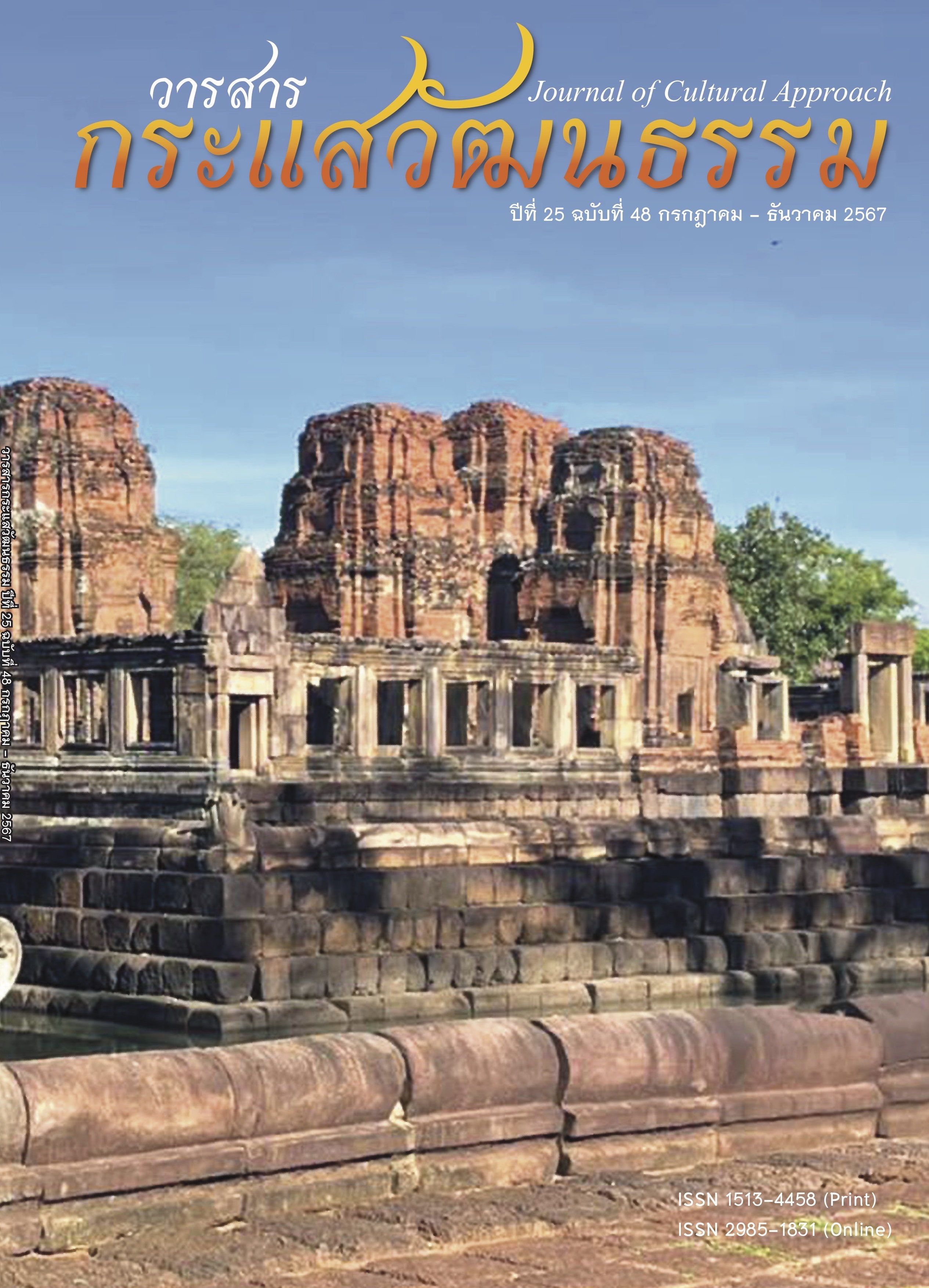Thai Wisdom for Thong-Yip Dessert Production in Central Province
Main Article Content
Abstract
This study examined the body of knowledge and patterns of knowledge inheritance in the production of traditional Thai sweets, called Thong Yip, by groups from the central region of Thailand. Qualitative research was employed, utilizing documents and in-depth interviews. The primary data sources were purposefully selected, involving 18 participants, including experts in Thong Yip and local entrepreneurs in the studied area. A content analysis was conducted with the obtained data.
The study revealed that the indigenous knowledge of Thong Yip production is a rich body of knowledge that has been passed down for over 300 years, spanning from the late Ayutthaya period to the present. This knowledge is deeply ingrained in individuals and is often transmitted within families or to extended relatives. If it is not transferred, it risks being lost with those individuals. To perpetuate this knowledge, relevant organizations should manage it in a clear and accessible learning format suitable for the contemporary era. The content should cover five aspects: 1) historical background; 2) materials and ingredients; 3) recipes; 4) production process; and 5) desirable characteristics of Thong Yip. The crucial knowledge management facets for sustaining Thong Yip production knowledge include: 1) knowledge acquisition; 2) knowledge storage; 3) knowledge application; and 4) knowledge transmission.
Article Details

This work is licensed under a Creative Commons Attribution-NonCommercial-NoDerivatives 4.0 International License.
Proposed Creative Commons Copyright Notices
1. Proposed Policy for Journals That Offer Open Access
Authors who publish with this journal agree to the following terms:
- Authors retain copyright and grant the journal right of first publication with the work simultaneously licensed under a Creative Commons Attribution License that allows others to share the work with an acknowledgement of the work's authorship and initial publication in this journal.
- Authors are able to enter into separate, additional contractual arrangements for the non-exclusive distribution of the journal's published version of the work (e.g., post it to an institutional repository or publish it in a book), with an acknowledgement of its initial publication in this journal.
- Authors are permitted and encouraged to post their work online (e.g., in institutional repositories or on their website) prior to and during the submission process, as it can lead to productive exchanges, as well as earlier and greater citation of published work (See The Effect of Open Access).
Proposed Policy for Journals That Offer Delayed Open Access
Authors who publish with this journal agree to the following terms:
- Authors retain copyright and grant the journal right of first publication, with the work [SPECIFY PERIOD OF TIME] after publication simultaneously licensed under a Creative Commons Attribution License that allows others to share the work with an acknowledgement of the work's authorship and initial publication in this journal.
- Authors are able to enter into separate, additional contractual arrangements for the non-exclusive distribution of the journal's published version of the work (e.g., post it to an institutional repository or publish it in a book), with an acknowledgement of its initial publication in this journal.
- Authors are permitted and encouraged to post their work online (e.g., in institutional repositories or on their website) prior to and during the submission process, as it can lead to productive exchanges, as well as earlier and greater citation of published work (See The Effect of Open Access).
References
Boonphila, N. (2016). Phu Tai Wisdom Cultural Cuisine in Udonthani. Journal of Community Development and Life Quality, 4(2), 224–234.
Changkwanyuen, P. (2003). Techniques for Writing and Producting Textbooks. Chulalongkorn University Press.
Dalkir, K. (2005). Knowledge Management in Theory and Practice. Butterworth–Heinemann.
Fine Arts Department. (1985). Verse of Food and Dessert. Khurusapha Publisher.
Ingpanchalap, W. (2002). Thai Desserts. Thai Wattana Panich Publishers.
Keyuraphan, L. (2018). Knowledge Management Models for Local Wisdom and Culture: A Case Study of Pak Phli District, Nakhon Nayok Province. VRU Research and Development Journal Science and Technology, 13(2), 75–85.
Lawatin, C. (2015). Thai Antiquity Food and Sweets Culture of Klong Kanom–wan Village, Pakkred District, Nontaburi Province. VRU Research and Development Journal Science and Technology, 10(1), 142–155.
Layim, T. (2023). Thai Desserts: Evolution and Application for Health. Journal of Cultural Approach, 23(44), 70–84.
Marquardt, M. (1996). Building the Learning Organization. McGraw–Hill.
McElroy, M. (1999). The Knowledge Life Cycle. Presented in the ICM Conference on KM, Miami.
Mertins, K., Heisig, P. & Vorbeck, J. (2003). Knowledge Management: Concepts and Best Practices. Springer.
Meyer, F. M. & Zack, M. H. (1996). The Design and Implementation of Information Products. Sloan Management Review, 37(3), 43–59.
Office of the Education Council. (2005). Guide for Recruitment and Selection of Thai Wisdom Teacher. Ministry of Education.
Phatsakonwong, P. (2011). Tamra Mae Khrua Hua Pa. Original Publisher.
Phlai Noi, S. (2018). Khanom Mae Oei. Sarakadee Publisher.
Reiko, H. (2007). Thao Thongkip Ma. Nanmeebooks Publications.
Srisukontharat, S., Prateep Na Thalang, S. & Kongmon, N. (2020). Knowledge Management of Local Food Culture in Phang Nga Province: Case Study of Thap Phut District. Journal of Human Society, 10(1), 45–52.
Thaphun, N. (2005). Thong Yip Sweets. Sangdad Publishing.
Wichianpanya, P. (2004). Knowledge Management: Basics and Applications. Export Net.
Wiig, K. (1993). Knowledge Management Foundation. Schema.
Zack, M. H. (1999). Developing a Knowledge Strategy. California Management Review, 41(3), 125–145.


